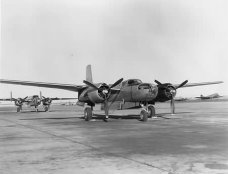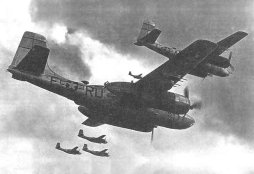
Douglas A-26 Invader
XA-26 41-19504, the Invader prototype, first took to the air on 10 July 1942. This aircraft had the glazed nose of the projected A-26C bomber variant. The A-26A night fighter would have had a radar set in the nose, with four 20 mm cannon in a ventral pack.
For attack missions, the A-26B had six 12.7 mm (0.50 cal) machine guns in its nose, remotely controlled dorsal and ventral turrets, each with two 12.7 mm machine guns, and up to 10 more in underwing and under fuselage packs.
The night fighter was cancelled, but the A-26B and A-26C models were rushed into production. The first Invaders in combat were four A-26Bs used in New Guinea, where the aircraft proved unpopular on low level sorties. Clearly, all the type's 'bugs' had yet to be ironed out.
In September 1944 the 553rd Bomb Squadron at Great Dunmow, England received 18 machines. Their results were more promising. Eventually, 11,567 missions were flown, delivering 18,344 tonnes (18,054 tons) of bombs. One aircraft was even credited with a probable 'kill' of an Me 262 jet fighter.
In the Pacific, air to ground and anti shipping strikes were typical. Three USAAF bomb groups used A-26s against targets in Okinawa, Formosa and mainland Japan; A-26s were active near Nagasaki when the second A-bomb was dropped on 9 August 1945.
Perhaps better known for its post war exploits, the Douglas A-26 Invader first served in the European and Pacific theatres of World War II from September 1944. Designed by ED Heinemann to replace the A-20 Havoc, the A-26 was very similar to the Havoc in configuration. The roles of bomber, night fighter and ground attack aircraft were envisaged for the type, but it was for air to ground roles that production aircraft were ordered.
 |
 |
 |
| A mixed complement of A-26s within the squadrons of a bomb group was not unusual. The 386th Bombardment Group operated both A-26Bs and Cs. |
This'gun nose' B model has four 12.7 mm (0.50 cal) machine guns on the starboard side and two to port. |
With eight extra machine guns in four underwing two guns packs, the two A-26s nearest the camera are a glazed nose A-26C (in the foreground) and an A-26B. |
|
Douglas A-26 Invader (Technical Specification) |
| Role |
Three seat light attack bomber |
| Manufacturer |
Douglas |
| Maximum Speed |
600 kmh (372 mph) |
| Maximum Range |
2,253 km (1,400 miles) |
| Ceiling |
6,735 meters (22,100 feet) |
Weight
Empty
Maximum Takeoff |
10,365 kg (22,803 lbs)
15,876 kg (34,927 lbs) |
Dimensions
Wingspan
Length
Height
Wing Area |
21.34 meters (70 ft)
15.62 meters (51 ft 3 in)
5.56 meters (18 ft 3 in)
50.17 square meters (540 sq ft) |
| Engines |
Two Pratt & Whitney R-2800-79 Double Wasp radial piston engines each providing 1,419-kW (2,000 hp) |
| Armament |
Six 12.7 mm (0.50 cal) machine guns (two each in nose, dorsal and ventral positions) plus 1,814 kg (4,000 lb) of bombs internally
|
Photo Gallery
Click here to submit your photo
| Have A Passion For Aircraft? |
Subscribe to our 14 series FREE newsletter
delivered weekly on World War 2 Aircraft factfile... |
| NB:- We hate spam as much as you do, so your email address will NEVER be shared with or sold to anyone else. That's a Guarantee. |
|
|





